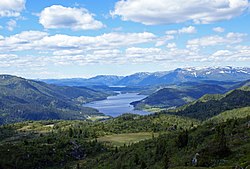
Back تلمارك العليا Arabic Øvre Telemark German טלמרק העליונה HE Øvre Telemark NB Øvre Telemark Swedish
Upper Telemark
Øvre Telemark (Norwegian) | |
|---|---|
 | |
 | |
| Coordinates: 59°54′00″N 8°24′00″E / 59.9000°N 8.4000°E | |
| Country | Norway |
| County | Telemark |
| Region | Østlandet |
| Biggest city | Notodden |
| Area | |
| • Total | 12,468 km2 (4,814 sq mi) |
| Population (2022)[2] | |
| • Total | 50,984 |
| • Density | 4.1/km2 (11/sq mi) |
| Demonym(s) | Teledøl Telemarking[3] |
Upper Telemark (Norwegian: Øvre Telemark) is a traditional district in Telemark county in Norway. The area includes the inland areas of Telemark. More than two-thirds of the total area of Telemark—more than 10,000 square kilometres (3,900 sq mi)—belong to the traditional region of Upper Telemark. Conversely, the area of "Lower" Telemark refers to the more densely populated, flatter coastal area of Grenland and traditionally also includes Central Telemark. Upper Telemark has a varied and often scenic landscape, with many hills, mountains, valleys and lakes.
Upper Telemark was originally known simply as Telemark and is named for the Thelir (Old Norse: Þilir), the ancient North Germanic tribe that inhabited what is now called Upper Telemark and Numedal in the Migration Period and the Viking Age. Upper Telemark is known for its folk traditions within music, clothing, handcrafts, food and architecture. The region is also distinctly marked by its dialect of Norwegian.
The district is also conventionally divided into Vest-Telemark and Aust-Telemark, with Vest-Telemark consisting of Vinje, Tokke, Seljord, Fyresdal, Kviteseid, and Nissedal. Aust-Telemark always consists of Hjartdal, Notodden, and Tinn, but more recently Midt-Telemark and Nome are also usually included as well.
Whereas Lower Telemark was traditionally dominated by the burghers of the cities, Upper Telemark was for centuries dominated by a close-knit "aristocracy of officials" comprised by a handful of families which monopolized the state and church offices in the region, notably the families Paus, Blom, Ørn, and Morland.[4]
- ^ Statistisk sentralbyrå. "09280: Area of land and fresh water (km²) (M)" (in Norwegian).
- ^ Statistisk sentralbyrå. "Table: 06913: Population 1 January and population changes during the calendar year (M)" (in Norwegian).
- ^ "Navn på steder og personer: Innbyggjarnamn" (in Norwegian). Språkrådet.
- ^ Nygaard, Jon (2013). «...af stort est du kommen». Henrik Ibsen og Skien (in Norwegian). Senter for Ibsen-studier. pp. 68 & 74. ISBN 9788291540122.
© MMXXIII Rich X Search. We shall prevail. All rights reserved. Rich X Search